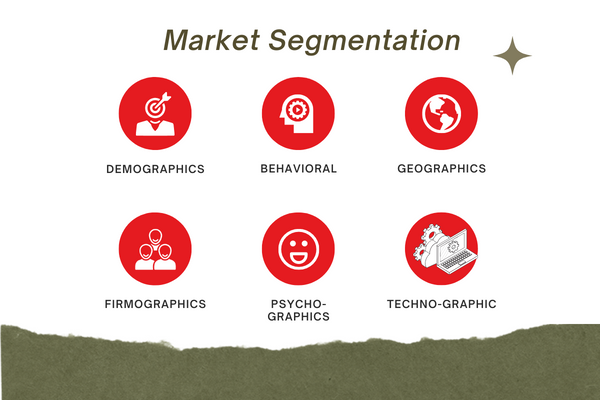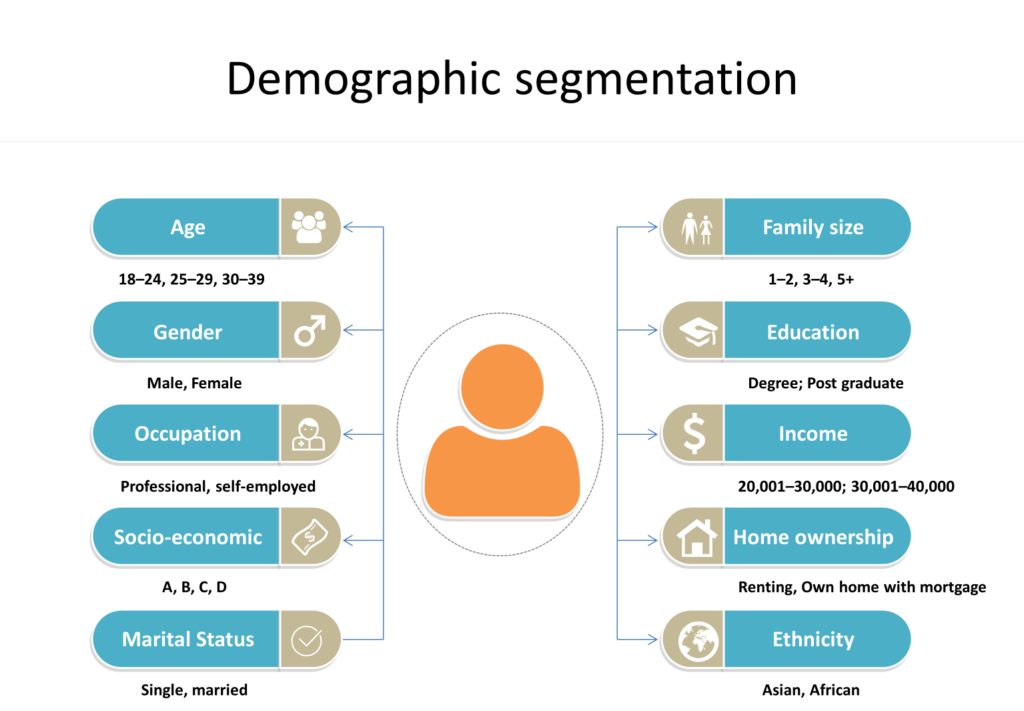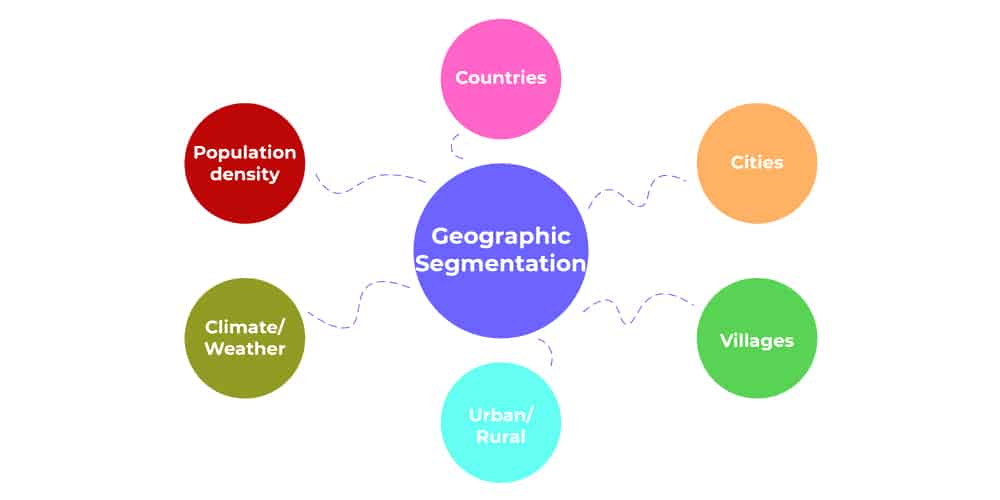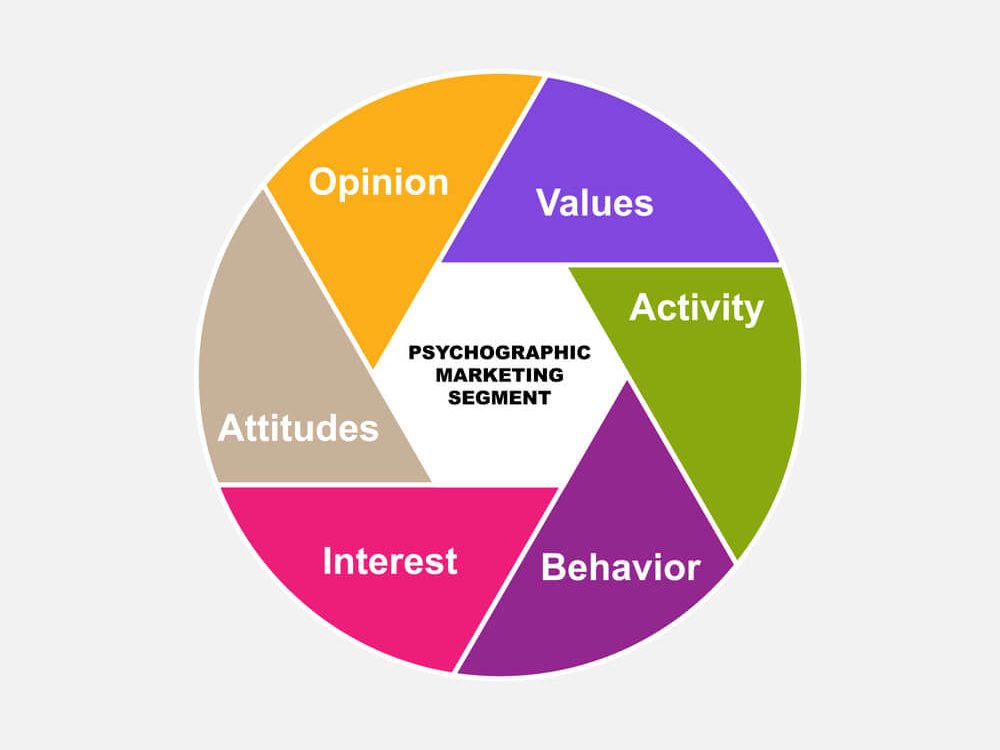Imagine you’ve created a fantastic marketing campaign with a compelling copy, an excellent headline, and an enticing value proposition but have no idea how to decide who should receive the proposal.
With billions of dollars spent on marketing worldwide, it is necessary to prove its ROI. ROI boils down to the success of your marketing efforts which is defined by identifying which people are more likely to respond and making the best use of them.
Market segmentation is meant to help you find out your market’s different needs and determine what best meets those needs and who out there should receive that proposal.
In this article:
- What is market segmentation?
- An overview of different types of market segmentation
- Benefits of market segmentation
- Quick recall
What is market segmentation?
Market segmentation divides the market into different groups of customers with similar needs and wants so that a business can better tailor its goods and services to the target market. Companies use the segmentation process to study their competitors to find new ways to differentiate themselves from rivals.
Segmentation divides the customer base into smaller groups based on similar traits, such as customers’ professional attributes, actions, needs, desires, personal characteristics, or other variables linked to customers’ personalities. These smaller segments are subsets of the larger target market, making it easier for businesses to understand customers’ behaviour, pain points, and motivations to deliver the best possible experience.
Proper customer segmentation allows for a better understanding of your customer base and the best ways to reach out to them effectively. This knowledge can garner more sales and marketing dollars for your company.
Also read: A Brief History Of Market Research
It can further help identify the target market with high growth potential, so you can focus on acquiring these new customers. At each step of the customer journey and product cycle, you need to determine which segment is at risk of not being reached. In other words, you will want to prioritise your marketing program(s) and adjust your products/services as needed.
An overview of different types of market segmentation

Customer segmentation is an essential step in any business. There are six main segmentation types, and within each class are many different sub-categories. There is so much information that it’s necessary to categorise customers based on a flexible set of criteria to understand your audience better. Let’s see the primary six here:
1. Demographic Segmentation

Demographics segment people into different groups based on their characteristics, such as:
- Ethnicity
- Gender
- Age
- Sex
- Children
- Marital Status
- Family Structure
- Level of Education
- Religion
2. Geographic Segmentation

Geography is essential – different areas have different climates and topographies that get better results. People have varying needs and preferences in these local settings. Geographical segmentation lets you pitch the best products to the right people, such as those who need a humidifier in the winter or a dehumidifier in the summer. You can use geographical segmentation to target customers with specific needs, such as shifting production to where you can get your products cheaper. Geographic segmentation helps you reach your target market by breaking the population into different geographic locations such as country, region, state, city, pin code, economic status, climate, and population density.
3. Behavioral Segmentation
Behavioural segmentation can be used to map your target market. It helps to understand the motivations, actions, and preferences for creating an immersive experience that resonates with this audience.
4. Psychographic Segmentation

Psychographic segmentation is a great way to get to know people better and design more tailored experiences by analysing customer personalities and values. Market research is easy to execute when you have so much information at your fingertips. It lets you explore what your target audience thinks, what they like, and often what they decide to spend their money on, so it will help you establish new opportunities. The segmentation is based on the following:
- Hobbies
- Goals
- Involvement in the community
- Social life
- Activities
- Beliefs
- Social status
5. Price Segmentation
According to the KPMG Global Online Consumer Report, ‘price’ is the most favoured attribute that impacts consumers’ purchasing decisions.
Consumers always consider whether the product is worth it or not. Providers are therefore advised to develop different customer solutions based on their needs. For example, consumers with lower purchasing power might be offered a cheaper alternative but one that still provides a viable service.
Price segmentation lets you offer the same or similar product at different prices to different customer segments. You can attract customers with budget constraints with lower prices and those willing to spend more with a higher price tag.
6. Technographic Segmentation
Finally, you can use technographic segmentation to group people according to the technology they use, like mobile or desktop. Not only can you sell better solutions in your business, but you also make targeting more effective.
Benefits of market Segmentation
Marketers, advertisers, and other teams benefit greatly from market segmentation. It can provide them with helpful insight into their target market. What they do, why they do it, whom they reach out to, and what responses they get are much easier to understand in this context.
1. It helps in creating precise buyer personas
Customer segmentation mitigates the risk of churn by allowing for more targeted content and messaging for groups of customers with similar traits. , i.e., affinity. It’s important not to oversimplify the segmentation of customers, as customer segments can be pretty broad and often have overlaps. For example, there is overlap between industries and professional areas; it’s often difficult to discern between a customer in advertising and marketing versus one in manufacturing or healthcare.
You can build buyer personas from your data, indicating the behaviour of people who are most likely to buy from you. This provides valuable insight into business opportunities and helps you understand how to connect with different clients.
Also read: Buyer Personas: Improve Your Marketing Strategy
How does building a buyer persona benefit your business?
- Aids in running price analysis
You can understand what your target audience is looking for by building a buyer persona and running a pricing analysis.
The idea of creating a buyer persona is not new to marketing. However, with the advancements in AI, it has become easier to build personas and run pricing analyses. This makes it easier for businesses to understand their target audience and create the content they want.
The exit intent survey and demographic data for your product page reveal that the customer segment is dropping off due to product pricing. Without data, you would not be able to make pricing decisions that are entirely tailored to your business’s needs. With A/B testing and statistical analysis, you can find the right combination of tiers for your clients and avoid wasting time on wrong decisions. Metlife serves as the best example in this category. - Helps in optimisation of user experience
By optimising user experience, companies can improve their conversion and reduce bounce rates. A buyer persona based on user experience can help in marketing and product development and enhance the quality of content on your website by understanding your audience better.
It also aids in improving customer retention rates by understanding what motivates them to buy from you and makes them leave you for someone else.
2. Different Segments get products tailored to their needs
Market segmentation is a valuable and effective way to gain a data-driven understanding of the needs of customers and the way they interact with your products. It helps you learn more about consumers and provide them with exactly what they want. Rushing your products to the market without understanding your customers doesn’t just hurt revenue. It creates a business environment where you can’t distinguish your best target demographics, which means you’ll be stuck in a saturated segment or underserved entirely. A product opportunity survey using questions like when did the product concept become popular will uncover new opportunities from previously unexplored demographic pools and create products
3. Helps in the proper allocation of resources and budget
Using key customer segments to accomplish marketing goals means you can optimise your time and investment potential.
Many marketers use market segmentation research to improve the effectiveness of email campaigns, find new market opportunities and more. Additionally, they can also retarget customers with their ads.
Knowing who your customers are is vital! When you know their fears and motivations and how they’re likely to act during their purchasing journey, you can use this data to streamline your marketing efforts.
How can segmentation help with resource allocation?
- By Providing appropriate Service Points
Mapping your crucial customer touchpoints and interactions can help you design an effortless customer journey. For instance, you can consider adding a language translation feature at your HelpDesk to cater to the target audience. Lego is an excellent example in this category, which used market segmentation to develop different social media marketing strategies based on customer demographics. - By Developing Marketing Programs Targeted to specific customers
Segmentation can help with resource allocation. Marketers can use segmentation to allocate their marketing budget according to the size of the segment they want to target.
With Marketing segmentation, you can easily find which marketing strategies are the most efficient. You’ll have all the data to back up your strategy, and you’ll be able to reach out to different targets effectively.
For example, you can design email campaigns for targeted customers with relevant product updates and advertise new offers tailored to them. - By Promoting the optimum use of resources
The limited resources in every business make it challenging to prioritise every customer and provide them with the same attention. Using data from your customers, you know the most important segments that can offer a high return for your company. These are what you should focus on first.
4. Aids in generating more leads
Segmenting your audience allows you to reach them with personalised messaging and offers specific to their needs and expectations. It helps entice potential customers to leave their contact information, thereby generating more leads.
How customer segmentation improves lead generation?
By streamlining the channels of distribution
In order to generate more leads, companies must streamline their distribution channels. This means that companies should focus on channels that produces the most leads rather than focusing on all of them. Customer segmentation helps generate more leads by focusing on specific channels with a high probability of lead generation.
You can develop a multi-channel approach to reach out to each segment most effectively by segmenting customers based on their preferences. Further, you can also organise where and how you would like your customer to present your message.
Using psychographic and demographic variables you can create more granular segments that can help determine other successful channels for increasing customer engagement and leads.
5. Helps improve customer retention and conversion
Retaining customers is a primary goal for all businesses, and customer retention is much simpler and cheaper than customer acquisition. You can obtain more detailed insights about your customers by looking at segmentation and focusing your time and energy on understanding the different customer groups, allowing you to develop solutions custom to each segment.
How segmentation improves customer retention?
Find out which demographic groups are and aren’t satisfied with your product. From there, find out why they aren’t happy. Then, create ways to bring them back.
Use the Recency, Frequency, and Monetary analysis to understand which of your customers are loyal and likely to upsell. This will help you determine how best to retain those customers while understanding what changes and resources you need to convert new ones.
Segment users based on their purchase behaviour. Then, reach out to these segments to see who is most likely to churn and measure what you can do to change the customer experience. For example, follow up with those customers who have not visited your website for a while but were regular a few days back.
How segmentation increases conversions?
- By Identifying the price tiers most suitable for customers
Pricing different products and services according to user segment is crucial in creating the right customer touchpoint.
Designing effective pricing tiers may be difficult, but with data-driven methods and effective targeting methods, your conversions will be improved. - By Finding the opportunity in timing to Increase Engagement
Customer segmentation is essential for improving the conversion rate and increasing sales. Capitalising on cultural, geographical, or demographic differences is important to capitalise on that information and grow your business’ revenue. For example, running a sales promotion on Diwali in India is sure to maximise sales.
Quick Recall
Market segmentation is a key factor in driving profitable and successful marketing campaigns. It can help companies identify their target audience and generate better conversions, higher ROI, and more profitable companies. With market segmentation
- You can understand the market you are targeting, and can create more targeted messaging that appeals to your specific audience.
- You will be able to build a more substantial customer base with less risk of losing customers because you know where they are coming from
- You will be able to identify new opportunities for growth by focusing on what your customers value most.
- You can optimise your marketing spending by focusing on the areas with the most potential for increased revenue.
Market segmentation is essential, and its benefits are unavoidable. However, you’ll want to be cautious when choosing your resources and experts, as there are many facets to consider.
















